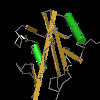?
 
Src homology 2 (SH2) domain found in the Vav2 proteins Proto-oncogene vav is a member of the Dbl family of guanine nucleotide exchange factors (GEF) for the Rho family of GTP binding proteins. All vavs are activated by tyrosine phosphorylation leading to their activation. There are three Vav mammalian family members: Vav1 which is expressed in the hematopoietic system, and Vav2 and Vav3 are more ubiquitously expressed. Vav2 is a GEF for RhoA, RhoB and RhoG and may activate Rac1 and Cdc42. Vav2 has been shown to interact with CD19 and Grb2. Alternatively spliced transcript variants encoding different isoforms have been found for Vav2. Vav proteins are involved in several processes that require cytoskeletal reorganization, such as the formation of the immunological synapse (IS), phagocytosis, platelet aggregation, spreading, and transformation. Vavs function as guanine nucleotide exchange factors (GEFs) for the Rho/Rac family of GTPases. Vav family members have several conserved motifs/domains including: a leucine-rich region, a leucine-zipper, a calponin homology (CH) domain, an acidic domain, a Dbl-homology (DH) domain, a pleckstrin homology (PH) domain, a cysteine-rich domain, 2 SH3 domains, a proline-rich region, and a SH2 domain. Vavs are the only known Rho GEFs that have both the DH/PH motifs and SH2/SH3 domains in the same protein. The leucine-rich helix-loop-helix (HLH) domain is thought to be involved in protein heterodimerization with other HLH proteins and it may function as a negative regulator by forming inactive heterodimers. The CH domain is usually involved in the association with filamentous actin, but in Vav it controls NFAT stimulation, Ca2+ mobilization, and its transforming activity. Acidic domains are involved in protein-protein interactions and contain regulatory tyrosines. The DH domain is a GDP-GTP exchange factor on Rho/Rac GTPases. The PH domain in involved in interactions with GTP-binding proteins, lipids and/or phosphorylated serine/threonine residues. The SH3 domain is involved in localization of proteins to specific sites within the cell interacting with protein with proline-rich sequences. The SH2 domain mediates a high affinity interaction with tyrosine phosphorylated proteins. In general SH2 domains are involved in signal transduction. They typically bind pTyr-containing ligands via two surface pockets, a pTyr and hydrophobic binding pocket, allowing proteins with SH2 domains to localize to tyrosine phosphorylated sites. |
